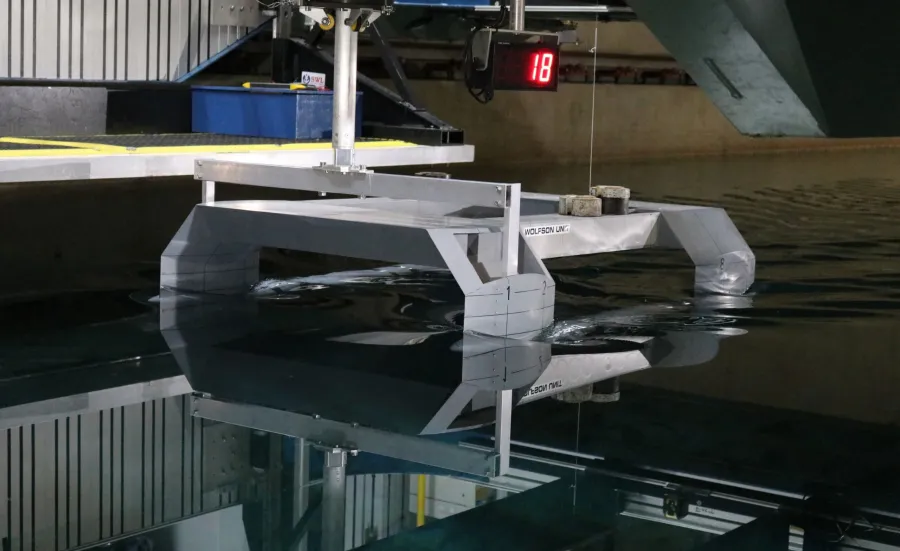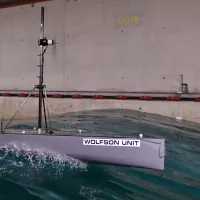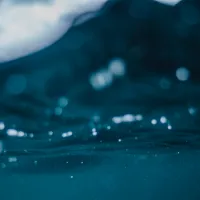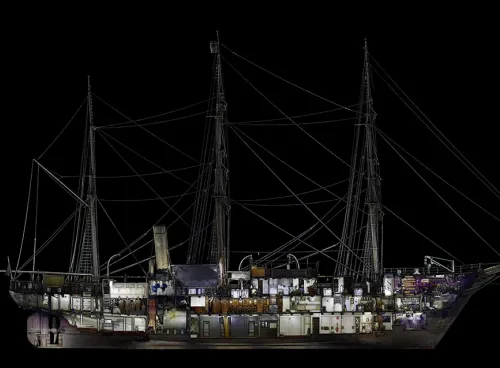Transport is among the biggest drivers of climate change, sliding in just behind the fossil fuel industry and agriculture as one of the largest emitters of carbon dioxide. It is responsible for around 20% of global emissions each year, and it’s not just aviation and road transport that are at fault – shipping is a major problem too.
What if we could cut down the destructive impact of shipping just by redesigning boats? At the University of Southampton, researchers are testing out a new generation of unmanned vessels that could rapidly decarbonise the marine industry worldwide.
At 138m long and 3.5m deep and producing a huge swell, the University’s Towing Tank is at the cutting edge of climate research. It helps scientists such as Dr Martyn Prince and Professor Dominic Taunton to really understand what happens to vessels at sea when they face the most dangerous conditions.
“Essentially, it’s a large swimming pool with what looks like a train track running over the top,” Martyn, the Wolfson Unit’s Principal Research Engineer explains. “We can take scale models through the water in various sea states to look at what would happen.”
Martyn and Dominic lead the interdisciplinary team for this research. The team includes academics from the Southampton Marine and Maritime Institute, working alongside designers from our partner company, ACUA Ocean. They are testing the potential for hydrogen-powered, unmanned vessels that could transform the maritime industry. Those hoping for a quick breakthrough will be the sectors set to benefit most. These include the defence industry for unmanned surveillance purposes, monitoring agencies, such as those recording the weather or scanning the seabed, as well as commercial shipping.
The idea is that you can push the vessel as hard as you can.
Dr Martyn Prince
The technology Martyn is testing is based on ships powered by fuel cells, but the fact they can run autonomously is the real boon to the climate. Carbon savings from unmanned vessels come from their ability not only to stay out on the ocean for much longer but also to work in conditions that humans couldn’t possibly tolerate – including dangerously high seas.
“The motion of most traditional vessels is relatively low so you’re not punishing the crew. In large waves you go slow to limit slamming,” Martyn says.
There are industry guidelines in place determining what kind of conditions sailors and merchant navy personnel should be exposed to, so they are both comfortable and can work efficiently. But without a crew, those restrictions fall away. Even better, there’s no need to provide other services on board such as heating, catering and lodging areas, all of which add weight and increase carbon emissions for every sea crossing.
Now, using the Towing Tank, Martyn is figuring out just how hard a solo vessel can be pushed. Almost all the information that the industry holds about how ships behave in tough conditions is based on vessels that come with a crew. “Once you take the human out of the system, you can push the vessel much harder. Then it becomes about the systems on board,” Martyn says.
During rigorous testing, the vessels are tested in all conditions from a small swell to huge waves and at different speeds to understand at what level of motion and in what kind of environment the technology can operate in.
The testing space has limits but, with the data gathered, Dominic can build mathematical tools to make predictions about what would happen in more challenging oceanic conditions that cannot be simulated in a tank. That includes important calculations such as fuel consumption rates.
Initial tests have been completed and now engineers at ACUA Ocean are moving on to designing and building a first full prototype. Tests on that product are expected within the next two years. If successful, they could begin cutting shipping's carbon burden within a decade.
Once you take the human out of the system, you can push the vessel much harder
Dr Martyn Prince





